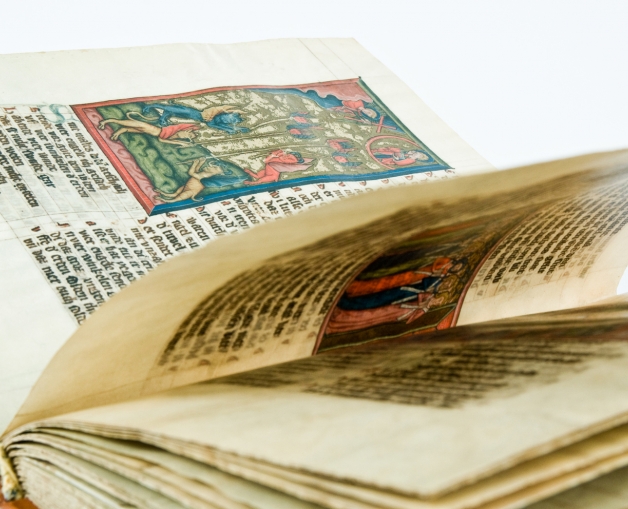Apokalypse
Heinrich von Hesler, Apokalypse, State of the Teutonic Order, 14th century
The unique Toruń facsimile copy of the manuscript of Heinrich von Hesler's "Apokalypse". The manuscript was ordered by Luder of Braunschweig, the great master of the Teutonic Order during the years 1331 - 1355, and was thus first stored in the Order's library in Malbork.
Limited Edition: 198 copies
Available: less than 3 copies
Heinrich von Hesler, Apokalypse, State of Teutonic Order, 14th century
Heinrich von Hesler, Apokalypse. Manuscript in German. 2nd third of the 14th century. Parchment. 30 x 21.5 cm, 160 leaves. Binding contemporary to manuscript: board, leather, remnants of two clasps.
Reference: Rps 64/III.
The Author
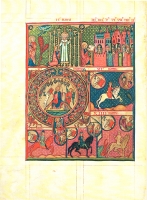 Leaf from the Stuttgart copy
Leaf from the Stuttgart copy
more >>
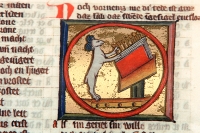 Illumination with gilding
Illumination with gilding
more >>
The author of the Apocalypse, Heinrich von Hesler, most probably came from a noble family from Hesler, in German Thuringia. Until recently it was believed that he was born ca. 1270 and died after 1347. It was also believed that he was a member of the Teutonic Order and was the provost and commander in Zschillen, in the Teutonic Bailiwick of Turin. Heinrich von Hesler was referenced to have occupied these posts in the 1330s and 1340s. It was widely believed that his works originated from the first decades of the 14th century. The Apocalypse was supposedly created at the beginning of that century. Apart from the Apocalypse, the History of Salvation and hypothetically the Gospel of Nicodemus are also attributed to Heinrich von Hesler. The work of Heinrich von Hesler was considered to be an integral part of the literature of the Teutonic Order. However, the last two discovered fragments of von Hesler’s the Apocalypse indicate that he might have written it as early as the 1260s. Accordingly, this discovery forced researcher to revisit their views on this period in Heinrich von Hesler’s life, the origin date of the Apocalypse and maybe even the circle in which it was created.
The Apocalypse is a translation, in so-called rhymed prose, to German of The Apocalypse of St. John, the last book of the New Testament. However, it is not a literal and complete translation. Heinrich von Hesler made the translation by interweaving it with the texts of medieval theologians and his own comments. An analysis of The Apocalypse attests to the profound and vast theological knowledge of the author. It is also worthwhile to mention the literary proficiency of Heinrich von Hesler. His verses and rhymes are of the highest quality, his Apocalypse features the so-called melodics, a quality rendering it particularly attractive when read aloud.
History
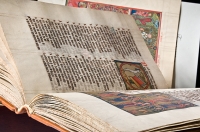 Apokalypse
Apokalypse
more >>
 Illumination
Illumination
more >>
Undoubtedly, the creation of the illuminated series of Heinrich von Hesler’s Apocalypses, which undoubtedly includes the two manuscripts discussed herein, can be traced to the order of Luther von Braunschweig, the Grand Master of the Teutonic Order throughout 1331-1335. Luther von Braunschweig was inspired with the Western European chivalric and court tradition which prompted him to use using the illuminations from the Apocalypse to presents ideas cherished by order knights. What distinguishes the Teutonic miniatures from their Western European counterparts is their close relation to the text. The illuminator who created the miniatures for the Apocalypse was probably inspired by similar English codices. However, the miniatures in the Teutonic series had a separate program – the illuminator introduced additional presentations and contents imposed by the sponsors. Apart from the vision of the City of God and the forces of evil, knights were shown as fighting and converting, acting for the benefit of the future fate of the Church on the Earth and as its integral part – they were included in God’s plans. The illumination of the series of Teutonic Apocalypses is the oldest example of the painted presentation of the ideology of the Teutonic Order.
Apart from the two “Toruń” copies of the Heinrich von Hesler’s the Apocalypse, a third illuminated copy of this work survives today. It is kept in the Württembergische Landesbibliothek in Stuttgart. Latest studies on the subject hypothesize that during the life of Luther von Braunschweig only the Stuttgart copy was created and the two Toruń copies were manufactured only after his death. Another two non-illuminated copies of the Apocalypse survive: the 14th copy currently resides in the Library of the Polish Academy of Sciences in Gdańsk and the 15th century copy is located in the University Library in Munich, as well as over a dozen fragments of this work.
 Apokalypse
Apokalypse
more >>
Codex reference number Rps 64/III containing Heinrich von Hesler’s Apocalypse was made by two writers. The writing used in the manuscript is the textualis, i.e. a book hand. The text of the Apocalypse was written in two columns. The manuscript boasts 35 beautiful gilded miniatures, painted by an unknown illuminator who probably came from Western Germany. 12 leaves are missing; these were either cut-out or torn. All these leaves featured miniatures. The first three leaves of the manuscript are blank.
Codex reference no. Rps 44/III contains Heinrich von Hesler’s Apocalypse and the so-called Königsberger Apokalypse (also known as Prosa-Apokalypse), i.e. the medieval prose translation of the Apocalypse of St. John to German. This manuscript was written in textualis by two writers. The text was written in two columns. The manuscript currently contains 45 miniatures. Only one leaf containing a miniature is missing.
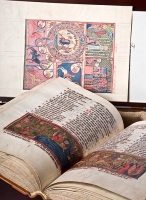 Apokalypse
Apokalypse
more >>
Both the above-mentioned manuscripts are sister manuscripts as the copies of the Apocalypse contained in them were written on the same number of leaves and have exactly the same number of miniatures in the same places. The differences between them, apart from the cut-out leaves, stem only from the fact that manuscript reference number Rps 44/II additionally contains the Königsberger Apokalypse and the miniatures in this copy were made by a different illuminator, though from the same workshop. The illuminations in this copy exhibit inferior workmanship and are not gilded, they also lack the precision of the miniatures in codex reference number Rps 64/III. It is assumed that both the copies were copied from a third one that failed to survive to today.
 Illumination
Illumination
more >>
Both codices were created in Ducal Prussia. Probably from the beginning they were stored in the library of the Teutonic Order in Marienburg. This is confirmed by the inventory of books stored in Marienburg taken from 1394 and 1398. After the Thirteen Years' War they were moved to a library in Tapiau. On 8 October 1541 they were moved from Tapiau to the newly-created Castle Library in Königsberg. They remained in Königsberg until World War II. At the end of the war, for security reasons, the codices along with valuable books from Königsberg were deposited by the Germans in Karwiny near Pasłęk which was incorporated into the Polish state in 1945. In 1947 this fragment of the Königsberg collections, from the so-called warehousing center for protected book collections in Pasłęk, was transported to the University Library in Toruń.
Facsimile
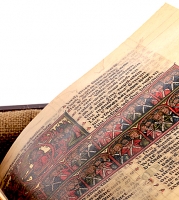 Illuminations
Illuminations
more >>
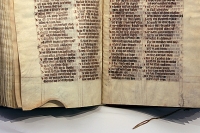 Restored characteristic damage
Restored characteristic damage
more >>
The only facsimile in the world of this manuscript was manufactured in accordance with the traditional principles of the craft. The photo-offset print was made on a special paper and additionally all gilded illuminations were made using screen printing. Leaves contain characteristic cracks and tears. These stem from the fact that parchment, a valuable and expensive material, even when slightly damaged during fleshing and dressing or smoothing was saved. These damages were often sewn together or even darned. In some cases these darns were specially ornamented. Today, after nearly seven ages the old threads simply crumbled. Here and there old pricks of the needle can still be seen. Due to humidity the parchment shrunk and exposed holes.In this copy these defects were meticulously recreated.
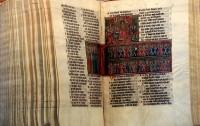 Illuminations
Illuminations
more >>
The book is missing twelve leaves, probably the most richly illuminated. Already in the 17th century, due to increasingly broad access to the work, thefts of richly decorated and thereby valuable handwritten leaves were quite common. Also in this case the relic failed to avoid damage. The manuscript, delivered in a box, comes attached with a separate leaf from the Stuttgart copy.
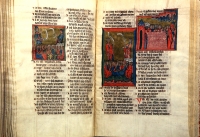 Illuminations
Illuminations
more >>
Its beautiful, full-page decorations further emphasize the value of the painting art from that period. The value and artistic charm of the remaining torn leaves are left to the imagination of the reader. Their remains are also noticeable in our copy. A separate notable element is the binding of the book. As in the original, two specially stabilised boards were used, as well as raw-tanned calfskin. Additionally, we have reproduced the stamps used to decorate the binding.
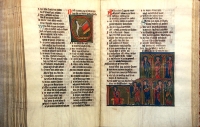 Illuminations
Illuminations
more >>
This way the blind-stamped hand-dyed leather conveys the graphic forms characteristic of medieval bounds. Also the clasps were reproduced from the remnants of the original. These are two brass casts forming the so-called pin clasp–rare and beautiful in its artistic form, yet robustly protecting the leaves of the book. The casts were additionally oxidized and cleaned which produced and aging effect. The book was finally packaged in a wooden box, padded with raw jute fabric-corresponding to values of the Middle Ages and aesthetics of the book.
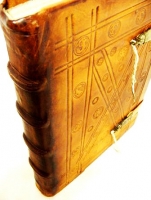 Joint
Joint
more >>
 Binding
Binding
more >>
 Binding - Front
Binding - Front
more >>
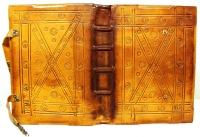 Binding
Binding
more >>
Specification
Heinrich von Hesler, Apokalypse, State of the Teutonic Order, 14th century
Dimensions: 235 x 320 x 65 mm
Number of folios: 162
Paper: pergamenata 170 g/cm2
Binding: boards dressed in blind-stamped leather, closed with two brass clasps, (binding could be different from what you see on the pictures)
Packaging: wooden box with jute padding; dimensions: 290 x 410 x 78 mm
Limited print-run: 198 copies. Available: less than 59 copies
Price: 2400€


